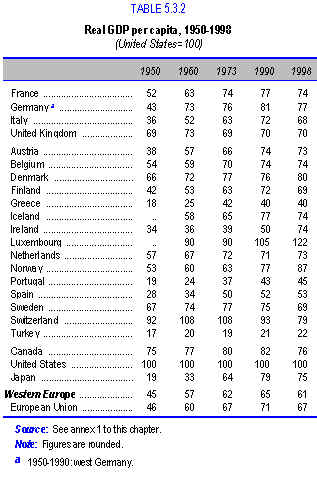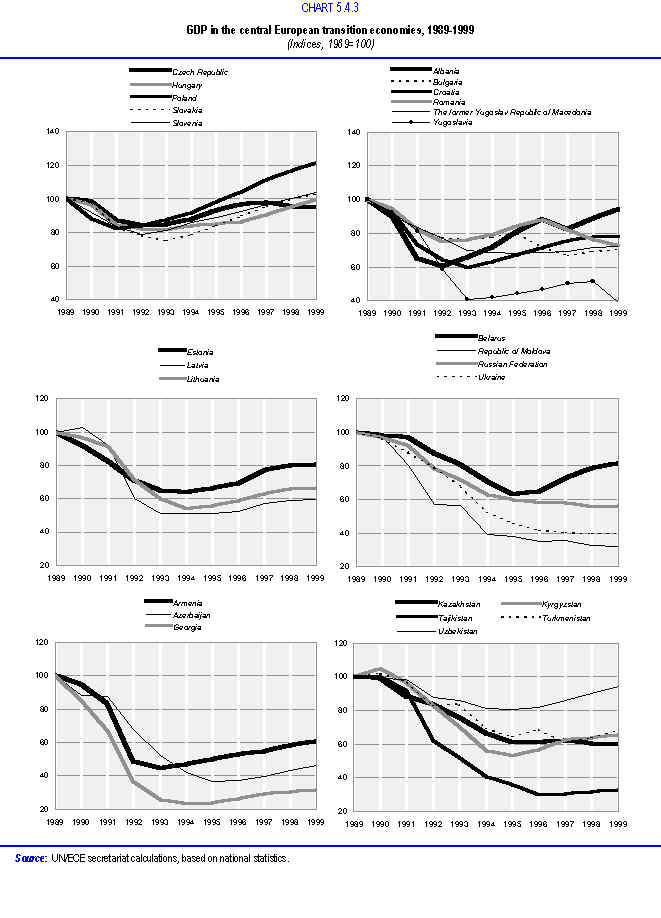Catching Up and Falling Behind: Economic Convergence in Europe
EMBARGO
Not to be released before
Wednesday, 3 May 2000
00:01 GMT
Press Release
ECE/GEN/00/14
Geneva, 26 April 2000
UN/ECE releases its first 2000
Economic Survey of Europe
Are the standards
of living of west Europeans catching up with those of north Americans? Are the standards
of living of the inhabitants of countries with economies in transition reaching west
European levels? Is there any convergence between all these countries in terms of per
capita GDP? Those are some among the many questions which are answered in chapter 5 of the
latest release of the Economic Survey of Europe 2000, No. 1 just published by
the United Nations Economic Commission for Europe (UN/ECE).
"The issue of convergence is not only
important in the context of west European economic and monetary integration",
stresses Paul Rayment, Director of the Economic Analysis Division of the UN/ECE, "but
also for the wider European integration process. One of the strategic goals of the
transition economies is to achieve sustained and high rates of economic growth that would
enable them to catch up with – to converge upon – the living standards of the
developed economies of western Europe. And many of them regard EU membership as
instrumental to promote this process."
Western Europe and North America - the
widening gap
"Since the early 1950s"
comments Dieter Hesse, a senior economist and head of the market economies section of the
UN/ECE, "there has been a long-run tendency for the inequality of real per capita GDP
across developed market economies of the region to decline over time. This so-called
"sigma convergence", however, was most pronounced during the period 1950-1973,
also known as the Golden Age of post-war economic growth. In contrast, there was a marked
slowdown in convergence in the post-1973 period." The progress in convergence in the
period 1950-1998 reflects a tendency for countries with below average per capita GDP in
the initial period to experience a faster rate of growth thereafter. The speed of
convergence is, however, very slow.
Using the per capita GDP of the United
States as a benchmark, the feature in western Europe was for strong convergence on the
United States’ real GDP per capita in the period 1950-1973, but this catch-up process
then slowed down markedly. "On average, there was little further progress in closing
the real income gap relative to the United States after 1973; in fact, the gap widened
slightly in the 1990s" stresses Dieter Hesse. Thus, despite considerable
progress since 1950, there remains a large difference between real per capita GDP in the
United States and in western Europe: the gap amounted to some 40 per cent for the
aggregate of 19 west European countries and some 33 per cent for the EU in 1998 (see
table 5.3.2).

The available evidence suggests that the
process of convergence to US per capita income levels (and also convergence within western
Europe) reflects to a large extent productivity catch-up and technical change. The notable
weakening of the tendency for convergence in western Europe after 1973 may be due to the
adverse impact of successive shocks on macroeconomic stability and longer-term growth
expectations. These, in turn, reduced the stimulus to fixed investment, which is the main
vehicle for technical change. Greater cyclical volatility can also influence the longer
term growth performance via its impact on "learning by doing" and,
therefore, on human capital formation, both of which may slow down in periods of low
growth or recession.
Progress in convergence has been uneven
across countries (notably at the European periphery) and over time, reflecting the
specific interactions between domestic and international factors and their impact on the
growth of individual countries. This suggests that the longer term growth performance of
each country is essentially unique, and therefore difficult to replicate. Ireland is a
prime example of convergence: its real per capita GDP rose from some 60 per cent of the EU
average in 1960 to 110 per cent in 1998. But the Irish success has been the result of the
favourable interaction of a host of specific factors (such as conducive changes in the
western European and global economic environment and a skilful policy designed to attract
foreign direct investments (FDI)) which is unlikely to be repeated elsewhere. Convergence
petered out into broad stagnation in Greece after 1973 and catch-up never really took off
in Turkey. In contrast, the performance in Portugal and Spain has been more pronounced,
although whether the outcome could have been even better remains an open question. The
more favourable outcome for Portugal and Spain compared with Greece after 1973 has been
associated inter alia with a greater emphasis on institutional adaptation,
macroeconomic stabilization, structural reforms and trade liberalization in the former two
countries, which together created a more conducive environment for foreign direct
investments (FDI).
The empirical evidence also emphasises the
inter-relatedness of short-term cyclical developments and longer term economic growth. In
fact, the growth performance of this group of developed market economies was rather uneven
over the period 1950-1998, with episodes of weaker growth followed by more or less long
periods of sustained dynamism (or vice versa). This points to the role of
country-specific characteristics, including (positive or adverse) shocks and policies in
determining long-term growth patterns apart from common factors such as technological
change. Thus, adverse cyclical conditions and arduous structural adjustments led to the
virtual stagnation of real per capita GDP in Sweden and even a small decline in
Switzerland in the 1990s.
Eastern Europe and the CIS: Divergence during the
Transition
"Despite all the methodological
difficulties and data problems, over the long run (during the 50-year period between 1950
and 2000), it is clear that there is little evidence of catching up by the former
centrally planned economy countries (CPEs) and their successor states on the per capita
income levels of the EU-15", says Rumen Dobrinsky, a senior economist in the
transition economies section of the UN/ECE. On the contrary, a comparison of per capita
GDP in the initial and final years reveals instead evidence of falling behind; the latter
is especially pronounced in the successor states of the Soviet Union after 1990. The only
evidence, which was found, of absolute convergence in per capita income levels within the
former CPEs as a group and in relation to some of the west European economies was during
the 1950s and 1960s. Starting from the 1970s the gaps in income levels started to widen
again.
"One striking result of our study is
that the eastern part of the continent was already characterized by high and increasing
economic heterogeneity by the end of the 1980s. This finding is at odds with the
widespread view that central planning and economic cooperation within the CMEA had
instigated a relatively high level of economic homogeneity and a leveling of per capita
income levels within the group", adds Rumen Dobrinsky. In fact, the Survey shows that the general slowing down of economic growth in the 1970s was followed by a
rapid divergence during the 1980s.
The start of economic and political
transformation after 1989 generated high hopes and expectations on the part of the peoples
living in the eastern part of the continent of fast improvement in their living standards
and of catching up with those prevailing in western Europe. However, the past decade has
been characterized by highly divergent paths of growth among the transition economies:
while some of them have embarked on a path of sustained recovery, others are still
struggling with the transformational recession (see chart 5.4.3). By 1999 the central
European transition economies had either regained (Poland, Slovakia, Slovenia) or were
close to their pre-transition GDP levels (Czech Republic, Hungary); at the same time in
countries such as Georgia, the Republic of Moldova, Ukraine and Yugoslavia, GDP in 1999
was a mere one third of its pre-transition level.

In 1999 the average per capita GDP level
(measured using purchasing power parities (PPP)) in the five central European transition
economies was 46 per cent of the average per capita GDP level in the EU-15, and this
proportion was almost unchanged from a decade ago, while in the seven south-east European
transition economies average per capita income had fallen to 22 per cent of the EU-15
average from 39 per cent in 1989. In the three Baltic states the average per capita GDP in
1999 was 31 per cent of the EU-15 average while for the CIS countries as a whole this
number was 24 per cent.
In general, the transition to a market
economy has brought about turbulent changes and growing evidence of economic heterogeneity
and divergence in per capita income levels in the former CPEs. At the same time there
emerged subgroups of transition economies in which per capita incomes were more
homogeneous. Some of them (notably central Europe during the second half of the 1990s)
were also beginning to catch up on west European levels, but most of the transition
economies continued to diverge from one another and to fall further behind the income
levels of western Europe.
"Convergence in Europe, namely, the
process closing of per capita income gaps between the transition economies and western
Europe, is likely to be long and difficult" stresses Rumen Dobrinsky. "The
time required for catching up can be estimated in decades, even for the more advanced
transition economies and under optimistic growth scenarios". The main prerequisite
for convergence in Europe is a rapid and sustained rate of growth of the transition
economies. Although their past experience may not be very encouraging, the start of
economic transformation has created an opportunity for breaking with the past and for
establishing a favourable environment for growth and catching up.
Several proximate factors are however
necessary for achieving high and sustained long-term economic growth. These are:
investment in physical and human capital; investment in research and development and
infrastructural development; openness to trade; the development and upgrading of financial
systems; and maintaining a generally acceptable distribution of wealth within each
country; as well as a range of institutional, social and political factors.
For further information please contact:
Economic Analysis Division
United Nations Economic Commission for Europe (UN/ECE)
Palais des Nations
CH - 1211 Geneva 10, Switzerland
Tel: (+41 22) 917 27 78
Fax: (+41 22) 917 03 09
E-mail: [email protected]
Website: http://www.unece.org/ead/ead_h.htm
|
In order to provide you
with a better service, we would appreciate it if you would send a copy of your
article to: Information Unit, United
Nations Economic Commission for Europe (UN/ECE), Palais des Nations, Room 356, CH - 1211
Geneva 10, Switzerland,
Tel: +(41 22) 917 44 44, Fax: +(41 22) 917
05 05,
E-mail: [email protected],
Website: http://www.unece.org
Thank you. |